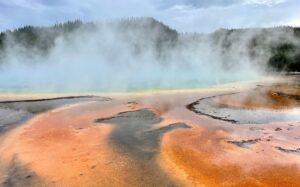
Yellowstone National Park —located partially in Idaho, Montana and Wyoming—puts modern volcanic activity on full display. Near boiling, ominous pools of water in the form of geysers, mud pots, fumaroles (vents that release steam) and hot springs are all present and active in the park and visitors flock to the park to view a handful of thermal features every year during the peak summer visitor season. Coincidentally, this is when a large portion of scientific research also takes place at the park. Combining both the boardwalk paths that are open to all who visit the park and the expansive backcountry, Yellowstone is host to over 10,000 thermal features. These thermal features are fed by superheated water that travels through a complex groundwater system—think the pipes under your kitchen sink—where subsurface water collects gases and chemical compounds en route to the surface. As a result, near-boiling water that bubbles through to the surface is often rife with chemicals like sulfur, iron or magnesium. Early scientists thought of hot springs as uninhabitable, but as it turns out, these conditions are just the right environment for thermophilic (or “heat-loving”) bacteria to thrive.
Where there is water and light, there is photosynthesis
Yellowstone pools host vibrant green, orange and pink microbial communities that puzzled scientists for decades. Following a series of field studies in Yellowstone, Thomas Brock published “Life at High Temperatures“, which revealed that many of these bacteria are photosynthetic. Photosynthetic bacteria are common in any environment where there is both light and liquid water because, like plants, they use light energy and water to convert carbon dioxide into sugars, carbohydrates and chemical energy. Brock and others have spent a lifetime exploring the role that photosynthetic bacteria play in the hot spring ecosystem. Because each hot spring in Yellowstone is like an individual island where inhabitants are limited to resources in and near the springs, photosynthetic bacteria are likely the major primary producers. In short, photosynthetic bacteria provide a source of bioavailable carbon to their hot spring neighbors while displaying vibrant pigmentation.
Hot springs as environmental laboratories for microbiologists
Hot springs are excellent sites for microbial ecologists to examine photosynthetic bacteria in their natural habitat. Before joining the Marketing Team at Promega, I was fortunate to spend almost five years thinking about nutrient cycling in hot springs and photosynthesis. I worked with Dr. Trinity Hamilton at the University of Minnesota to build on the large body of work encompassing photosynthesis in Yellowstone hot springs (1).
Prior to my first field campaign, I completed an exhaustive literature review of these works and found that there are many types of photosynthetic bacteria that are not well studied, but prevalent in alkaline hot springs. Thus began a dissertation on a charismatic group of photosynthetic bacteria that form pink, orange or green carpet-like structures (microbial mats) and are named for their flexible metabolism: the Chloroflexi. Our collaborative effort combines the work of multiple field campaigns and next generation sequencing – a suite of tools that allow microbiologists to examine microbial communities in their natural habitat. Our work supports the idea that microbial communities are complex, ever-changing and extremely important to nutrient cycling in hot springs. Additionally, we found that many high temperature, photosynthetic Chloroflexi have genes – which we can think of as tools in a toolbox that is their genome – to transform inorganic nitrogen and carbon into bioavailable carbon at very high temperatures (nearly 70 Celsius, 158 Fahrenheit). Near-boiling water would cause severe, potentially even fatal, burns to human and animal flesh, yet this where photosynthetic Chloroflexi thrive. The biotechnology field is constantly searching for microbes that perform complex metabolic tasks in high temperature, extreme environments. After all, the enzyme Taq polymerase was originally isolated from a thermophilic organism in a Yellowstone National Park hot spring and is essential in PCR testing for COVID-19. While I could go on about these beautifully complex bacteria for pages (see my dissertation for an ad nauseum account), I will end with this: Yellowstone National Park hot spring bacteria are key to progress in the fields of microbial ecology and applied microbiology, all while dazzling visitors of the park with their bright, vibrant communities.
References
- Tank, M., Thiel, V., Ward, D.M., Bryant, D.A. (2017). A Panoply of Phototrophs: An Overview of the Thermophilic Chlorophototrophs of the Microbial Mats of Alkaline Siliceous Hot Springs in Yellowstone National Park, WY, USA. In: Hallenbeck, P. (eds) Modern Topics in the Phototrophic Prokaryotes. Springer, Cham. https://doi.org/10.1007/978-3-319-46261-5_3
